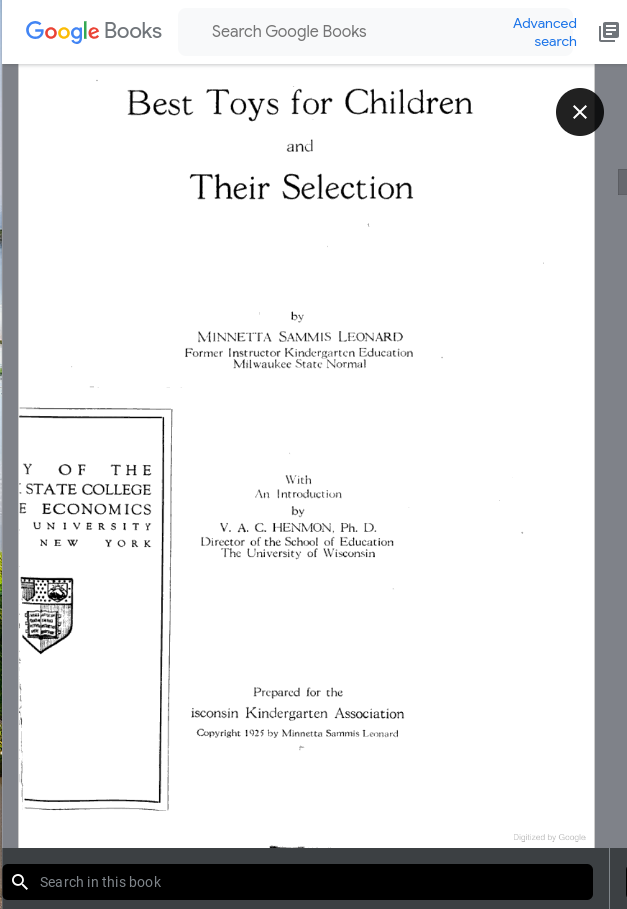I have been researching classic children’s toys from the beginning of last century. My honest desire is to find some free project plans from books that are past copyright and bring them back to life in the present. But I stumbled on a book that gives a glimpse of perspectives on selecting toys from 1925. Let’s check out these perspectives to see what has changed and what never goes out of fashion.
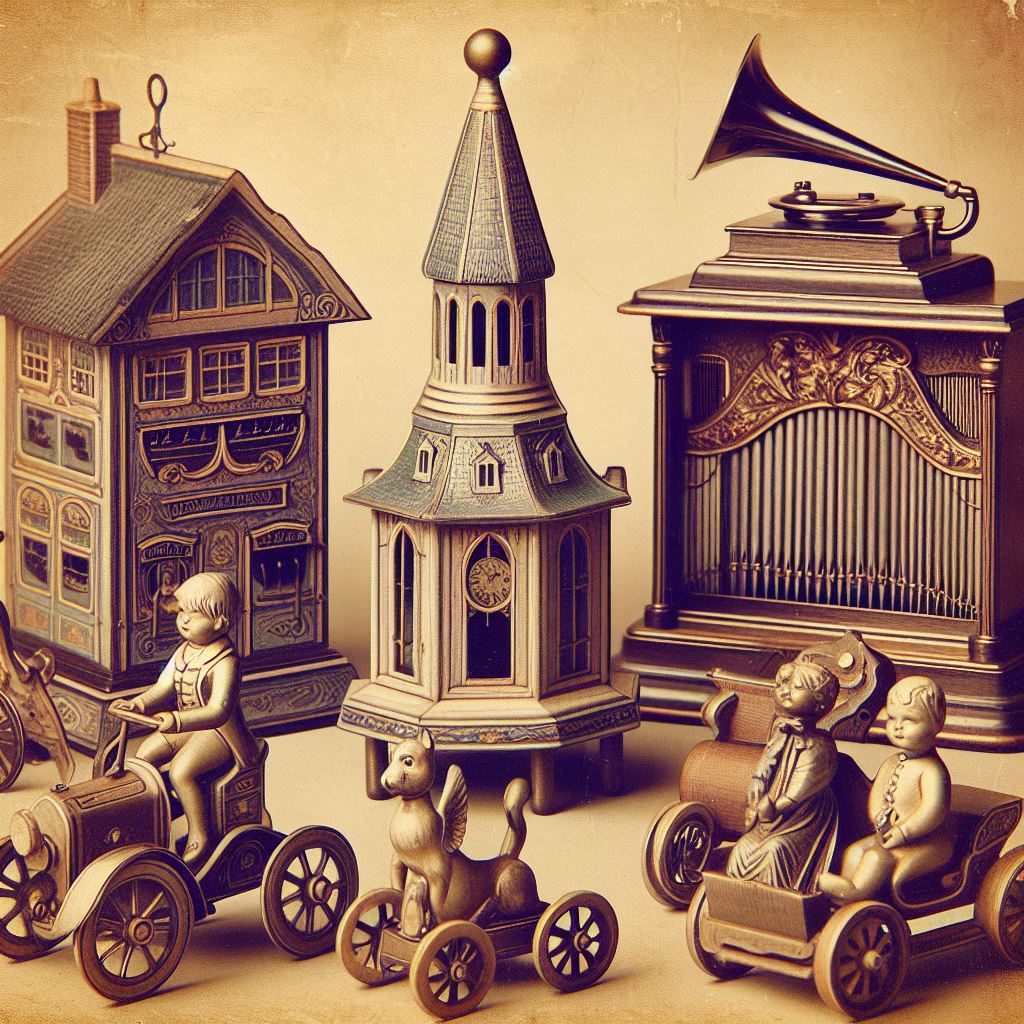
In my research using Google Books, I found the following book: “Best Toys for Children and Their Selection,” by Minnetta Sammis Leonard. Written in 1925, you can find the book on Google Books for free: here:
Even a hundred years ago, parents and teachers were concerned about how the earliest play and education would form the development of the little human beings later in life. These diligent educators were looking to start kiddos on the right foot with “healthy bodies, healthy emotions and healthy minds.”
But treating adolescent education seriously before the age of six was just catching on at the time, and the link between early education and play was a nascent field of study.
– Minnetta Sammis Leonard (circa 1925)
We are witnessing today, however, a great change in our conceptions of the educational importance of the early years as a result of closer study of infant behavior and of increasing knowledge of the way in which early habits, acquired likes and dislikes, and emotional attachments are built up and the way in which they condition the individual’s entire later life.
Formation of Character
Early childhood education held a crucial emphasis on character development, an aspect largely overlooked today. This book reveals that character formation was considered a vital pillar of a child’s growth, alongside skill acquisition and knowledge accumulation.
The prevailing belief was that emotions and feelings would guide children towards specific likes and dislikes, fostering the growth of certain sentiments. These sentiments, in turn, were thought to influence children’s pursuit of virtue or vice, ultimately impacting society as a whole. Consequently, educators focused on guiding children’s passions towards reason, empowering them to make wise choices later in life.
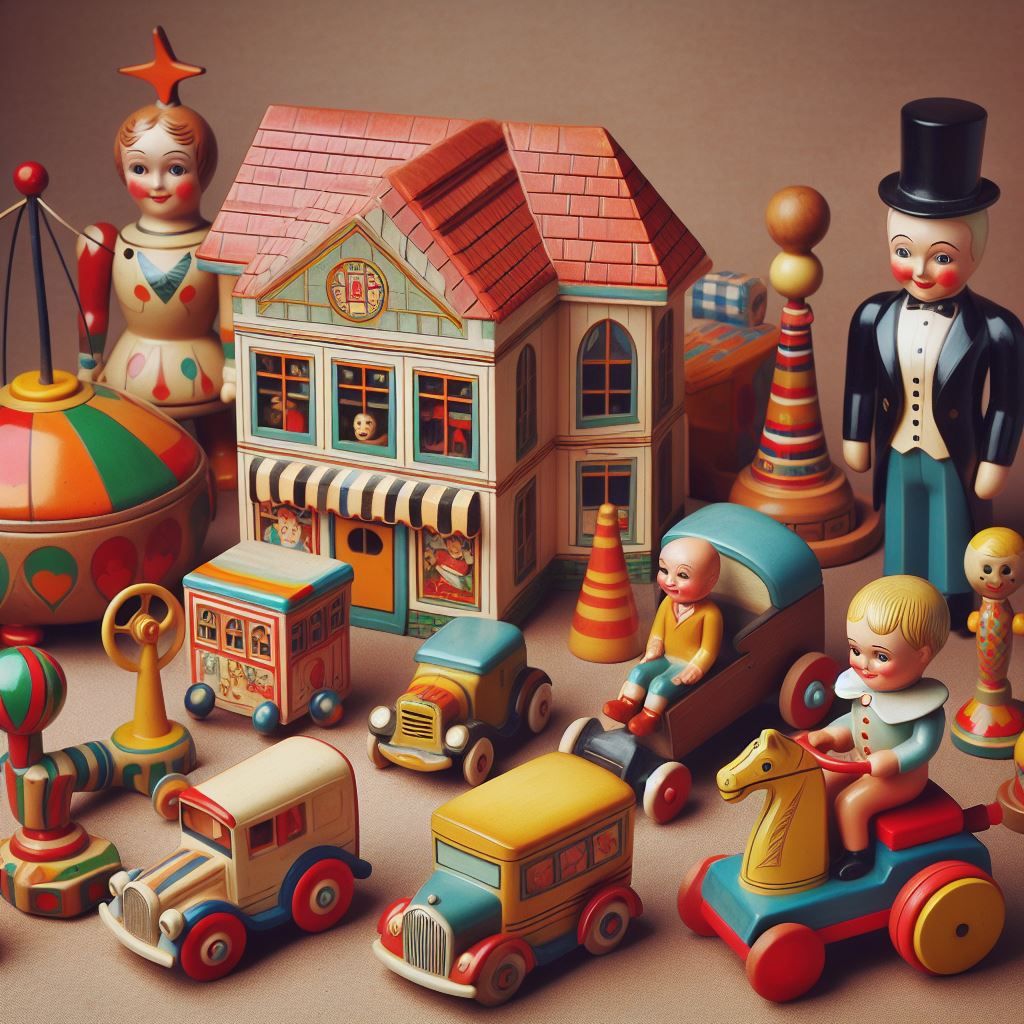
Seen from this lens, can we judge toys in their ability to steer children toward moral virtue and a formation of strong character?
Questions to Ask When Buying a Toy
See which resonate with you from 100 years ago:
- What good habits may be encouraged through play with this toy?
- The habit of keeping wholesomely busy
- Happy and productive employment
- The child learns to love real achievement
- Appreciation of good workmanship by others
- Habits of care for materials, economy in their use, neatness, order and thrift
- What bad habits may be fostered through its use?
- Lack of playthings and wholesome activity leads to idleness, mischief, and day dreaming.
- Too many playthings leads to many evils: carelessness and destructiveness, greed, fickleness, and indifference
- Do-nothing toys that stimulate laziness and love of being entertained.
- Toys which do it all and encourage the child to sit back and watch
- Toys too hard for the child which leads to the adult doing all the work
- Novelties picked up at random corner stores
- Children expect new excitement and never understand the value of money
- Cheap and easily breakable toys
- At any given age what are the dominant interests which need exercise?
- What toys will stimulate and exercise these interests to help form desirable permanent habits?
- Physical exercisers which exercise all parts of the body
- Sense Developers – water, sand, bubble pipes, color cubes
- Toys for “Make-believe” – dolls, animals, toys for house keeping, playing store, farming, etc.
- Building toys – Blocks, boards, boxes and carpentry materials
- Handwork materials – clay scissors, various papers, crayons, paints, sewing, etc.
- Games for indoor and out to develop physical and mental skills and encourage play with others.
- Specific questions about the toy:
- What qualities shall we look for?
- What kinds of toys to avoid?
- What are the standards for the various classes of toys?
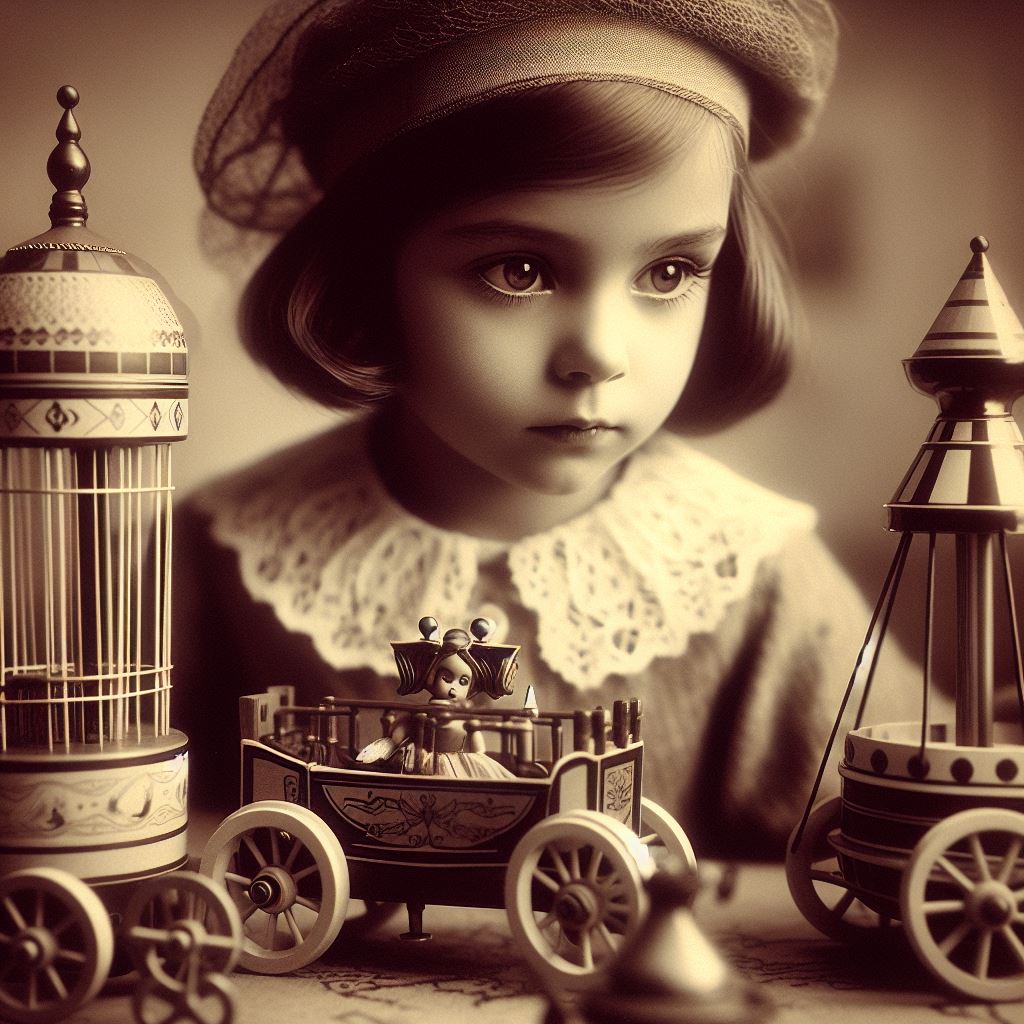
Toys For Specific Ages
Baby in the Cradle
Toys that encourage the awaking of the senses to understand the “quality of things.” – small bells, rattles, soft smooth rubber balls and woolly balls. Brightly colored wooden beads and tinker-toy dolls and animals also help his development. Plus, they should be easily cleanable.
Learning to Crawl and Walk
A ball to roll on the floor and crawl, walk or run after. Large but soft objects to climb on, small kiddie-kars and rocking chair horses. Plus, additional toys to stimulate muscle development.
Toddler toys include:
- A rattle with bells
- A heavy wooden train
- Small Wagon or wheelbarrow
- Doll Carriage
- Rocking Horse
- Sand Box
- Small doll or stuffed animals
- Small chair
- Chair swing
- Large play yard
- Blocks with rounded corners
Age 2 – 4 Years Old
At this age it’s the encouragement of the natural interests: imitating people, animals and things, exploring new things: their sounds, what they do when pounded, dropped, sucked or cut, and generally explore all things. First things, then speech about them.
The child is also developing joy in rhythmic sound and movements, claiming toys as “mine” and enjoying praise.
“Now parents must begin to exercise wisdom by giving notice and praise to the child, not for looks, over which he has no control, but for what he can do. Grave dangers lie here. Centering the attention upon himself rather than the thing he produces or the results of his behavior is likely to be injurious– this is the show-off age.”
– Minnetta Sammis Leonard (circa 1925)
Toys for 2 – 4 years include:
- Balls of all sizes
- Sturdy push and pull toys
- Large floor blocks (not smaller than 3x3x3 inch bricks)
- Dominos
- Hammer and various sized nails
- Paper and blunt scissors
- Black board for drawing and painting
- Various materials to crafts
- Clay
- Household toys like mother’s and father’s tools
- Dolls and animals for both girls and boys
- Furniture and toy dishes
- Good Table
- Rag Doll
- Large colored crayons
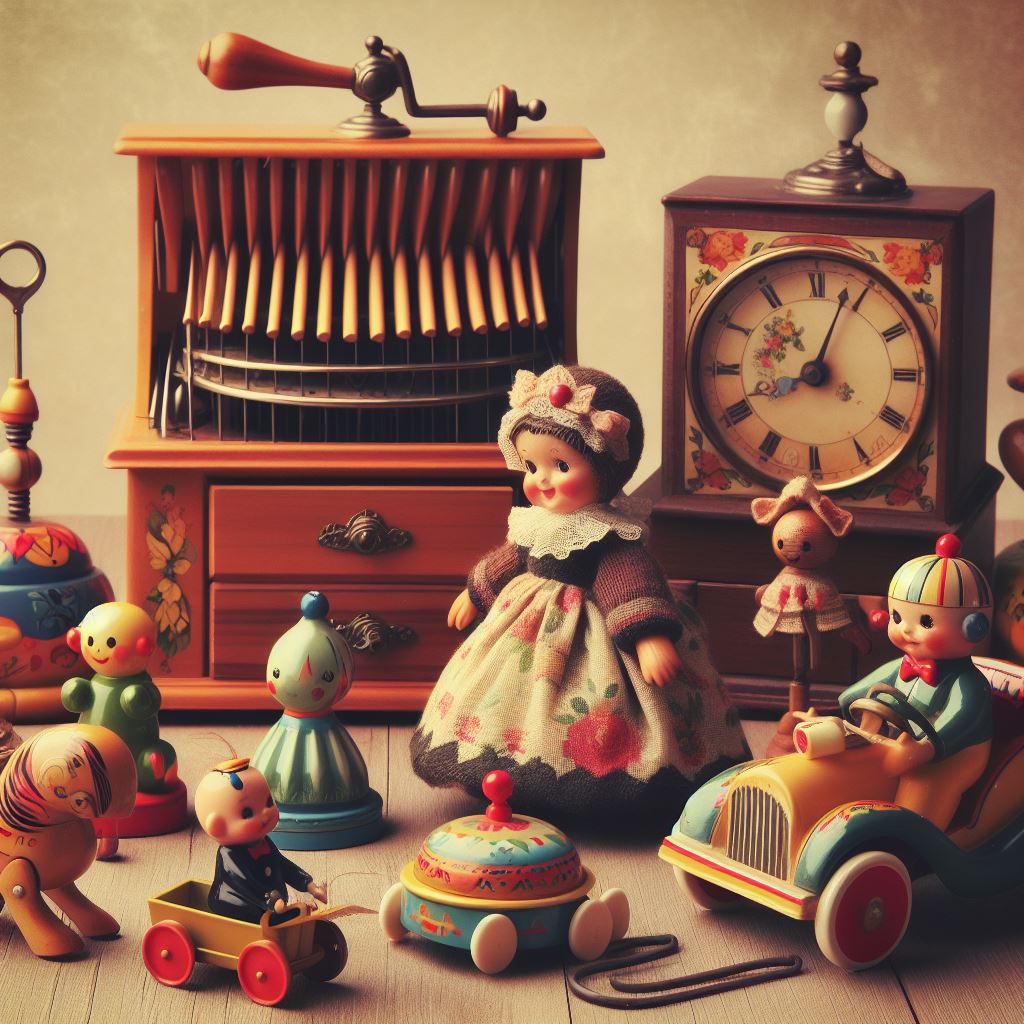
Ages 4-6 Years Old
Fixing good habits are tantamount along with taking care of their toys and pride of making things.
Toys for 4 – 6 years old include:
- Swing, rings, trapeze, and bars
- Steering sled
- Wagon to steer
- Jump ropes
- Skates, ice and roller
- Boxing gloves
- Football
- Punching bag
- Bean-bag and toss game
- Balancing toys
- Slide
- Merry-go-round, seesaw
- Make believe tool chest
Six Years Old and Over
Increasing physical activity and control with “stunt” toys at this age can be added including rings, parallel bars, and trapezes. Girls are recommended to add complicated cooking and sewing materials while both boys and girls can add carpenter tools and art tools with books giving directions on how to use.
Toys for 6 and older include:
- Meccano or erector sets
- Real electric trains or electric toys with books to help experiment
- Typewriter with paper
- Block printing set
- Stamp books and money saving devices
- Parlor games such as tiddledy winks, parchesi, checkers, and the like
“By the time a child can read it is wise to select some one activity in which he is especially interested… An outfit of good tools, nails, paints, patterns, and directions for wood working.”
– Minnetta Sammis Leonard (circa 1925)
Conclusion
It is great to see both parents and educators a hundred years ago concerned as much about children’s development as the present. But how often do we take a framework into consideration before selecting a toy for a child? Probably not much; instead price and play-value are perhaps the top considerations. It’s still interesting to see the emphasis on defining moral character for a child rather than focusing on our present day discussions of toy safety and whether batteries are included.
For the toys themselves, many of the toys mentioned can still be found in modern nurseries including blocks, arts and crafts materials, along with wooden trains and cars. Other toys have fallen out of favor like the erector set and rocking horses. Moreover, beyond the expected gender stereotypes of the time, I was surprised and delighted to see young girls were encouraged to receive tools for carpentry and fine arts. That shifted my assumptions from the time.
These ubiquitous toys of past and present give me an idea: Let’s find (or make) quality project plans for each one of these common toys and put them on Timber Topia. Likely, they will endure a few more generations into the future. And being well built and sturdy, we can escape the alleged evils of cheap and easily breakable toys, which having been a problem in the past, will likely continue to test future parent’s resolve to say no to their begging children waiting in line next to an isle of delights.
Selecting toys from a hundred years ago have many of the same considerations as today. So thumbs up for more woodworking- for both boys and girls to learn, but also, and the potentially beneficial moral character developments.
